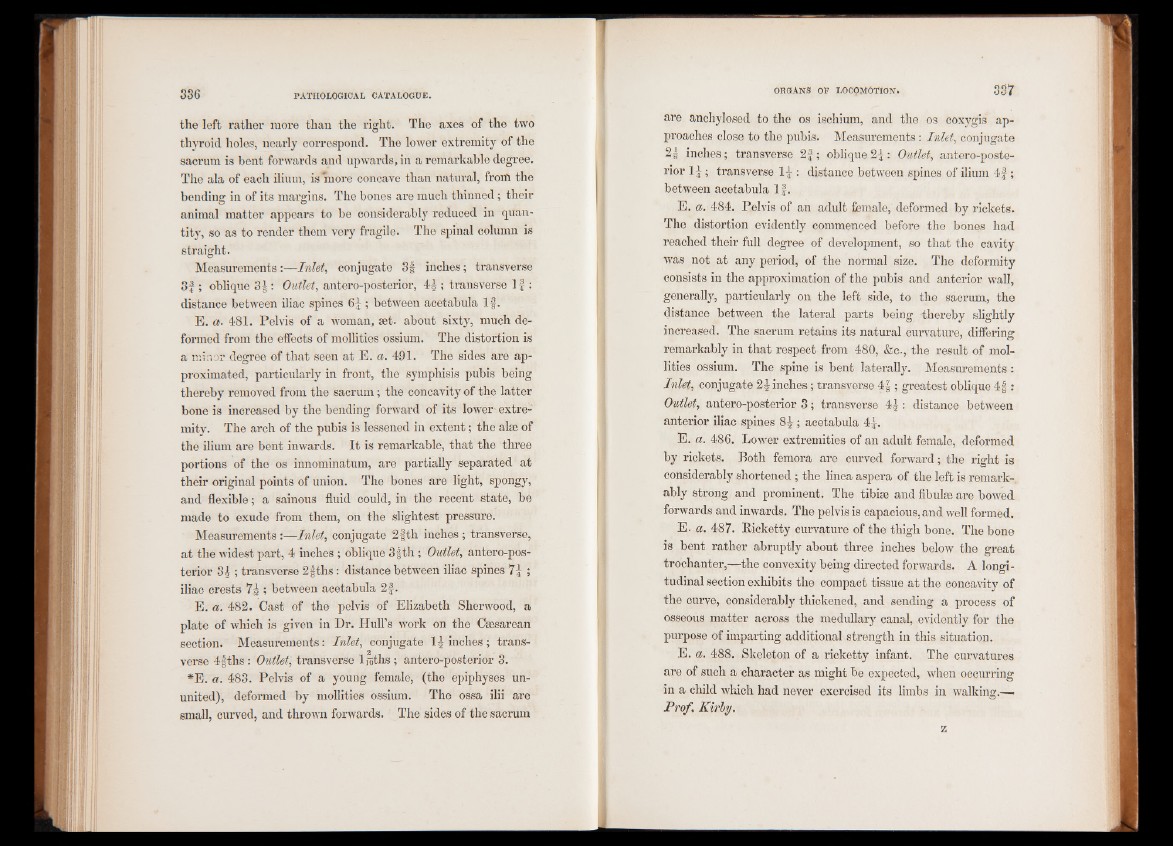
the left rather more than the right. The axes of the two
thyroid holes, nearly correspond. The lower extremity of the
sacrum is bent forwards and upwards, in a remarkable degree.
The ala of each ilium, is "more concave than natural, from the
bending in of its margins. The bones are much thinned ; their
animal matter appears to be considerably reduced in quantity,
so as to render them very fragile. The spinal column is
straight.
Measurements :—Inlet, conjugate 3f inches; transverse
3f ; oblique 3 |: Outlet, antero-posterior, 4-|; transverse If :
distance between iliac spines 6f ; between acetabula If.
E. a. 481. Pelvis of a Woman, set. about sixty, much deformed
from the effects of mollities ossium. The distortion is
a minor degree of that seen at E. a. 491. The sides are approximated,
particularly in front, the symphisis pubis being
thereby removed from the sacrum; the concavity of the latter
bone is increased by the bending forward of its lower- extremity.
The arch of the pubis is lessened in extent; the alee of
the ilium are bent inwards. It is remarkable, that the three
portions of the os mnominatum, are partially separated at
their original points of union. The bones are light, spongy,
and flexible; a sainous fluid could, in the recent state, be
made to exude from them, on the slightest pressure.
Measurements :—Inlet, conjugate 2§th inches; transverse,
at the widest part, 4 inches ; oblique Sfth ; Outlet, antero-posterior
3k ; transverse 2§ths: distance between iliac spines 7| ;
iliac crests 7g ; between acetabula 2f.
E. a. 482. Oast of the pelvis of Elizabeth Sherwood, a
plate of which is given in Dr. Hull’s work on the Caesarean
section. Measurements: Inlet, conjugate Jjs inches ; trans- verse 4fths: Outlet, transverse lf2oths ; antero-posterior 3.
*E. a. 483. Pelvis of a young female, (the epiphyses ununited),
deformed by mollities ossium. The ossa ilii are
small, curved, and thrown forwards. The sides of the sacrum
are anchylosed to the os ischium, and the os coxygis approaches
close to the pubis. Measurements: Inlet, conjugate
inches; transverse 2f; oblique 2}: Outlet, antero-posterior
l j-; transverse : distance between spines of ilium 4 f;
between acetabula If.
E. a. 484. Pelvis of an adult female, deformed by rickets.
The distortion evidently commenced before the bones had
reached their full degree of development, so that the cavity
was not at any period, of the normal size. The deformity
consists in the approximation of the pubis and anterior wall,
generally, particularly on the left side, to the sacrum, the
distance between the lateral parts being thereby slightly
increased. The sacrum retains its natural curvature, differing
remarkably in that respect from 480, &c., the result of mollities
ossium. The spine is bent laterally. Measurements:
Inlet, conjugate inches; transverse 4 |; greatest oblique 4| :
Outlet, antero-posterior 3; transverse 4^: distance between
anterior iliac spines 8^ ; acetabula 4f.
E. a. 486. Lower extremities of an adult female, deformed
by rickets. Both femora are curved forward; the right is
considerably shortened ; the linea aspera of the left is remark-,
ably strong and prominent. The tibise and fibulae are bowed
forwards and inwards. The pelvis is capacious, and well formed.
E. a. 487. Ricketty curvature of the thigh bone. The bone
is bent rather abruptly about three inches below the great
trochanter,—the convexity being directed forwards. A longitudinal
section exhibits the compact tissue at the concavity of
the curve, considerably thickened, and sending a process of
osseous matter across the medullary canal, evidently for the
purpose of imparting additional strength in this situation.
E. a. 488. Skeleton of a ricketty infant. The curvatures
are of such a character as might be expected, when occurring
in a child which had never exercised its limbs in walking.— O Prof. Kirby.
z